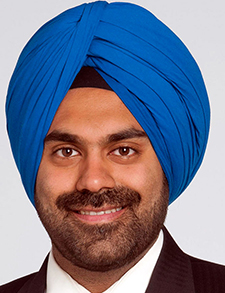
Success is defined differently by different leaders.
Some leaders of SHM chapters might be sated by having won a 2022 Silver Award.
Not Tanveer Singh, MD, FACP, FRCP (Edin), FHM, president of the Lake Erie/Northeast Ohio chapter.

Dr. Singh
“We were very excited to win the award,” said Dr. Singh, associate staff in the department of hospital medicine at Cleveland Clinic Community Care in Mayfield Heights, Ohio. “We were very proud of the work that everybody in the chapter has done. The next time, we are looking to get the Gold award…that’s the goal. It inspires us to get better.”
Dr. Singh, who joined SHM in 2019, says he joined SHM and quickly saw his professional society as his home. When chapter leaders approached him to get involved, doing it felt like payback for “the connections and great networking” it afforded him.
“The biggest thing to being in the leadership position in the chapter is it gives me the opportunity to look at the functioning of SHM at a closer level,” he said. “It also helps me shape the future of the chapter. And, most importantly, I think it gives me a way to develop my own leadership skills working with the other members and other leaders.”
Part of leadership is branching out, and Dr. Singh sees that as a pathway to growth for his chapter. He is working with the Ohio chapter of the American College of Physicians to do a joint event that he hopes will help lure members.
“It will put the name of SHM out there and will encourage the other hospitalists in the area to join,” Dr. Singh said.
Any chapter leader—regardless of whether their curriculum vitae includes a national award—will attest that member engagement is the key to a healthy chapter. Dr. Singh says regular contact is a touchstone to keep local hospital-medicine practitioners happy.
“The way I try to approach it is by talking to the colleagues I work with and sending them a periodic email and showing them the value of these sessions,” he said. “And also reaching out to my fellow hospitalists in other institutions, even though I don’t directly work with them, and see if they find certain sessions that they feel will help with their professional growth.”
In a medical market like Northeast Ohio, one of the challenges is feeling like the only institution that matters is the behemoth that is the Cleveland Clinic, from which the chapter draws most of its members.
“I want to have more hospitals, more physicians from different hospitals, join our chapter,” Dr. Singh said. To do that, the chapter is starting to have at least one leadership position from outside the Cleveland Clinic system. “We want to have more diversity in our leadership…we want to have hospitalists from those institutions join the leadership rank, as well, so we can expand the leadership, and thus they go back to their institutions and discuss with their colleagues to show them the value of becoming a member of SHM.”
But it’s not just headline names, hospitals, and hospitalists Dr. Singh wants to attract.
“I think there is also a value involving the residents and [advanced practice practitioners] so they can see some of the value of SHM,” he said. “We gear at least one session every year toward residents. These are the future physicians, the future hospitalists, and we can have them join SHM at this stage of their career so we can have continuous involvement from their side throughout their careers.”
Dr. Singh notes that engaging early-career practitioners means they often take membership and active involvement even more to heart, often viewing chapters more as a passion project than a professional obligation. That’s one reason the chapter created a resident liaison position, to create a bridge.
“Especially if they are on a hospitalist track, they know this is going to be their career, so it helps them to be involved early,” he said. “It also helps the chapter so that we can have new thoughts.”
All of the initiatives Dr. Singh sees for his chapter’s future involve branching out: More diverse geography; more diverse membership; more sessions on topics members want. In the end, the idea is that reaching more people with more of what they want will create its own momentum as they realize the chapter—and by association, SHM—exists and succeeds only with its members.
“Every hospitalist is just as valuable,” Dr. Singh said. “That’s what we want to show them. I think once they get a sense of community, it kind of spreads. I think initially we have to break the ice and show them that if they join the community, they will get real resources as a member of the chapter.”
Richard Quinn is a freelance writer in New Jersey.